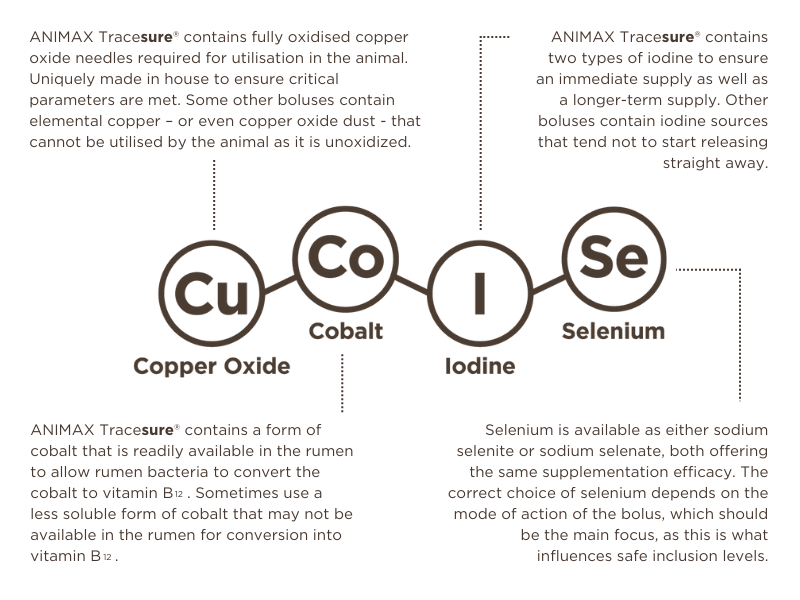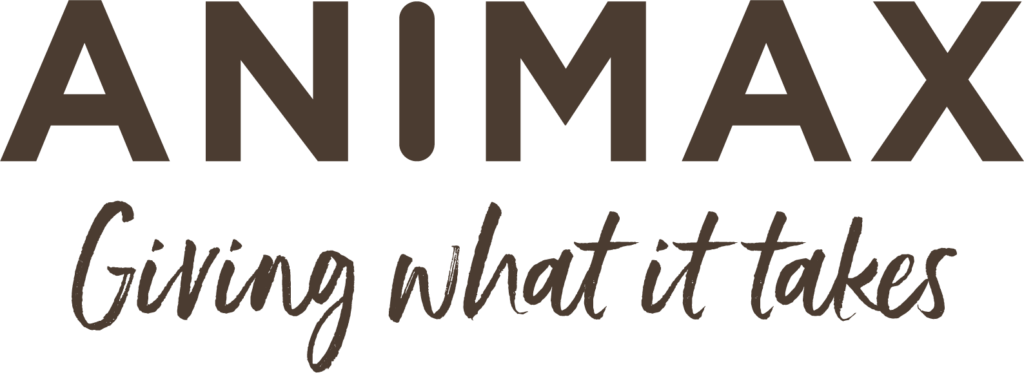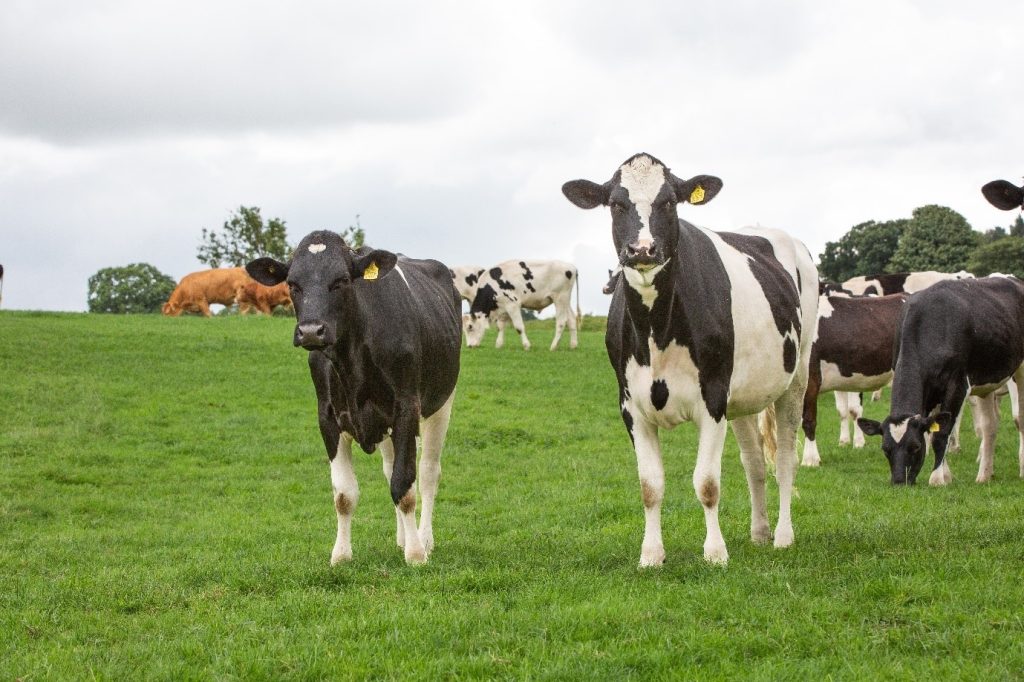With rearing dairy heifers one of the costliest operations on farm, doing everything you can to ensure heifers are calving down well is nothing short of critical.
There is also the hot topic of greenhouse gas emissions to consider. Given that grassland acts as a ‘sink’ for greenhouse gas, farmers are being pushed to feed cattle with minimal supplementary compound feeds.
Getting dairy heifers in good condition off forage ready for calving
Dairy heifers approaching calving should be at 85-90% of their fully mature weight – around 570 kg for a Holstein dairy heifer for example. This means a target growth rate of 0.7-0.8 kg per day, unless the replacement dairy heifer has exceeded her target weight at breeding, in which case her DLWG may reduce between breeding and calving.
Maiden dairy heifers that are springing to calve should have a body condition score of 2.75-3.0. Compared to heifers in good condition, thin heifers are study-proven to have a 30-day-longer period between calving and first oestrus / bulling (Source: AHDB). Thin/Poor condition heifers are also more likely to experience lameness, calving issues, and/or impacted colostrum quantity and quality. Calf development, vigour and mortality will also be impacted. Heifers that are fat can encounter similar issues.
In the interest of input costs and the environment, the goal will be to condition off grass with minimal supplementary feeding such as compounds or lick buckets. Typical grazing diets will need to include pre-grazing covers of 3,000 kg DM/ha and residuals of between 1500-1700 kg DM/ha where management and conditions allow, in a 21 day rotation in mid-season. When housed, typical diets will contain grass silage (28-32 kg fresh), energy MJ (92-104 MJ) and protein (11-13%).
8 top tips to get dairy heifers fit for calving:
- Offer a balanced diet and a comfortable environment, keeping it all consistent for at least 6 weeks before calving.
- Have a robust but responsible vaccination programme – against Leptospirosis, BVD, IBR, Salmonella and even calf scour – in place.
- Implement a hoof health and digital dermatitis control programme.
- Run heifers through the parlour to get used to environment and feeding.
- Introduce into the milking herd after the evening milking if possible.
- Monitor health closely and treat any issues quickly.
- Ensure adequate feeding, drinking and lying space.
- Watch out for insects that transmit diseases and irritate cattle.
If heifers are already down calving and exposed to calcium deficiency, ANIMAX EasyCal+® is a great option. The ANIMAX Easycal+® paste is a fast acting calcium to reduce the risk of milk fever. Containing 40-60% higher levels than some other oral calcium products and offering 12 to 15 hours of supply.
Minerals and trace elements are vital coming into calving
A balanced diet with adequate levels of energy and protein CANNOT do its full job if supplied without adequate minerals and trace elements. Enough of a supply of all the essential trace elements is imperative for heifers to digest grass and forage, stand up to health challenges, and develop the growing foetus.
Almost all soil, and therefore grass and forage, in the UK and Ireland is deficient in cobalt, copper, iodine, and selenium. Heifers are also often naturally exposed to trace element antagonists – such as iron, manganese, sulphur, aluminium, and molybdenum – that can compromise trace element uptake. If heifers do not have enough of these trace elements, they are significantly more predisposed to:
- Calving difficulties,
- Post-calving infections, and
- Metabolic disorders such as mastitis and retained cleansing.
Furthermore, the health of the newborn calf can be significantly impacted by the trace elements passively supplied within the uterus.
Where a deficiency is tested for, heifers should be supplemented with trace elements at least 6-8 weeks before calving to ensure good reserves. Choosing the mode of supplementation will come down to practicalities and precision.
Bolusing can be given in one hit and can offer an assured supply without the need to supplementary feed or if intakes are compromised over the calving period, meaning its supplementation you can count on. So, now to weight up the different available bolus technologies…
A comparison of the available bolus technologies for dairy heifers
| Trace element levels (mg total) | Bolus number required | Suitable Liveweight | Duration of cover | Mode of action | ||||
| Product | Cobalt | Copper | Iodine | Selenium | ||||
| ANIMAX Tracesure® Cattle | 500 | 30,000 | 3,400 | 500 | 1 | 200-500kg | 180 days | Diffusion |
| ANIMAX Tracesure® Cattle XL | 500 | 60,000 | 6,800 | 1008 | 1 | 500 kg+ | 180 days | Diffusion |
| All-Trace
Cattle |
480 | 32,640 | 1,056 | 504 | 2 | 200 kg+ | 240 days | Eroding |
| 24:7 Smartrace Adult Cattle Plus | 486 | 25,200
(optional) |
4,410 | 216 | 1 | 200 kg+ | 180 days | Eroding |
| All-trace High Iodine | 468 | 31,518 | 3,496 | 486 | 2 | 200 kg+ | 180 days | Dissolving |
| All-trace Dry cow | 480 | 11,628 | 2,112 | 276 | 2 | 400 kg+ | 120 days | Dissolving |
| Bimeda® COSEICURE Cattle | 500 | 13,400 | 1,000 | 300 | 1 / 2 | 100 kg+ /
250 kg+ |
180 days | Dissolving |
| Mayo
All Guard |
500 | 30,000
(optional) |
5,000 | 500 | 1 / 2 | 200 kg+ /
500kg+ |
180 days | Oxidising |
| Endurabol® Pre-calver | 480 | 11,628 | 2,112 | 276 | 2 | 150 kg+ | 120 days | Eroding |
| Oligovet™
High Iodine (ROI only) |
585 | – | 2,910 | 150 | 2 | 400 kg+ | 150 days | Diffusion |
| Oligovet™ Copper Plus
(ROI only) |
– | 15,102 | – | 151 | 2 | 400 kg+ | 180 days | Diffusion |
| Oligovet™
Pro Pasture (ROI only) |
1,100
/ 4.40 |
38,500
/ 154 |
4,125
/ 16.50 |
1100
/ 4.40 |
1 | 400 kg+ | 250 days | Diffusion |
5 facts to consider:
1️⃣ What trace elements are required at what levels
2️⃣ The actual trace element levels supplied per day
3️⃣ How well the trace elements can be absorbed
4️⃣ The risk of the bolus passing prematurely
5️⃣ Whether claims are supported by credible research
ANIMAX Tracesure® features patented diffusion technology® to ensure the bolus retains its size and weight over time, meaning superior ruminal retention and low risk of premature passing during the 6 months of cover.
ANIMAX Tracesure® also offers superior forms of trace elements:

Approved for use on organic systems
Study shows a reduction in calving challenges
Holstein Friesian cows on 4 farms were split into 2 groups – a non-bolus group and a group bolused with ANIMAX Tracesure® before calving. The group bolused with ANIMAX Tracesure® had 6% less incidents of retained foetal membranes compared to the non-bolus group.
With the cost of two ANIMAX Tracesure® Cattle boluses at £11.60 / €13.63 per cow*, and the total cost of a retained placenta including losses due to increased calving interval, loss of milk production and veterinary treatment totals approximately £471.00 / €553.00 per cow. The net benefit is £1,666.00 / €1957.00 per 100 cows*. ROI 1.7 : 1
* As at list price on 01/03/2023


